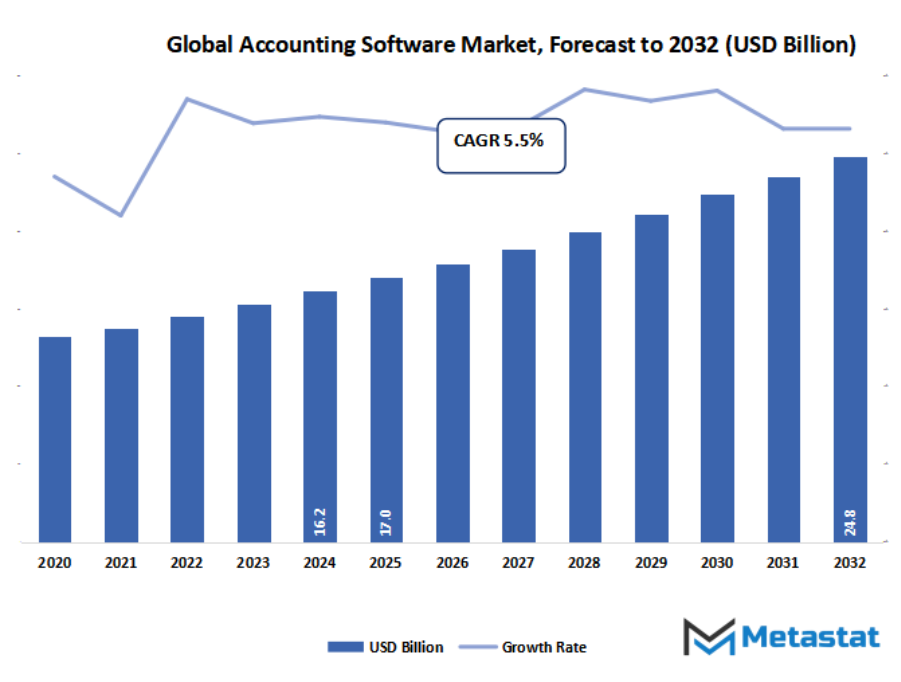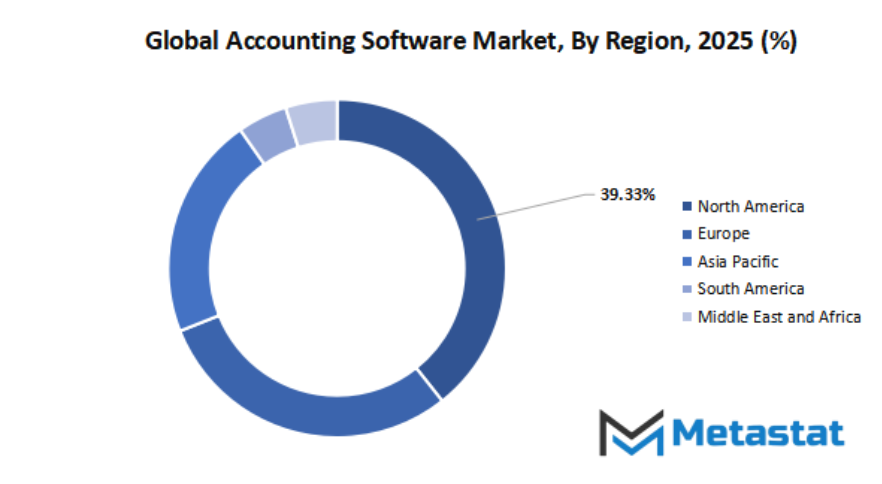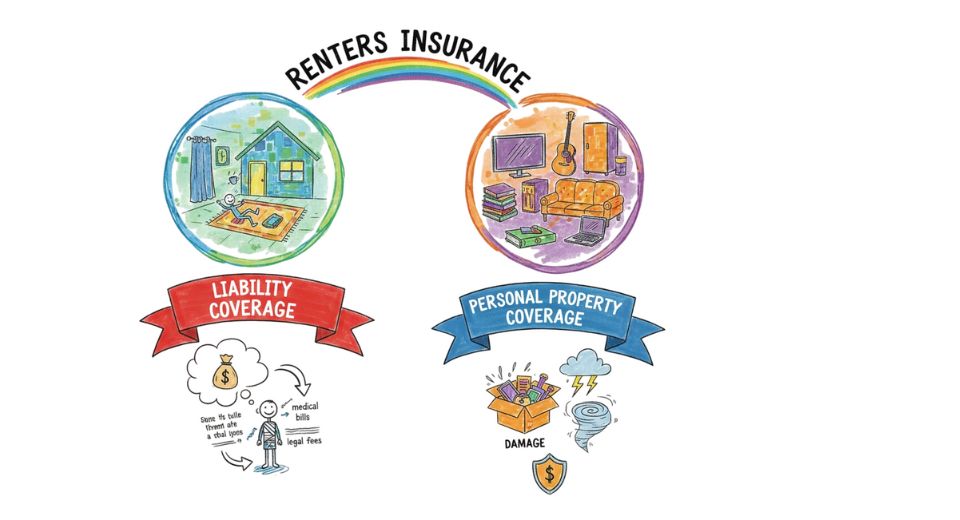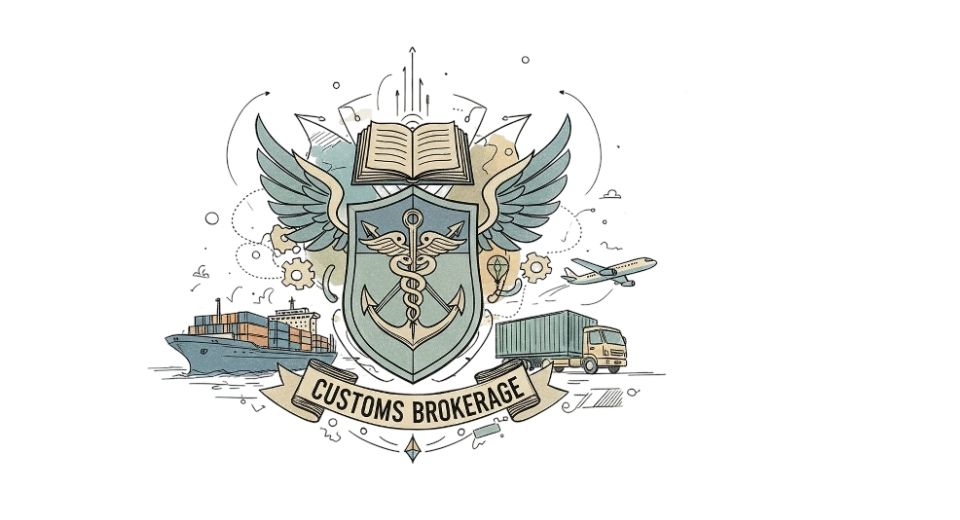Global Accounting Software Market - Comprehensive Data-Driven Market Analysis & Strategic Outlook
The global accounting software market and its industry will go much beyond the limits of mere financial tracking, slowly remodeling the way companies deal with data and decision-making. While companies in all industries tend towards digital transformation, this market will not only offer bookkeeping tools but will build platforms that forecast needs, process automation, and enable sophisticated analytics. The emphasis will be placed on providing integrated platforms on which accounting software integrates seamlessly with supply chains, human resources, and customer management systems so that businesses can work with a more coherent flow of information.
- Global accounting software market valued at approximately USD 17 Billion in 2025, growing at a CAGR of around 5.5% through 2032, with potential to exceed USD 24.8 Billion.
- Software account for nearly 68.2% market revenues, driving innovation and expanding applications through intense research.
- Key trends driving growth: Increasing adoption of digital tools for financial efficiency and real-time reporting., Regulatory requirements for accurate tax filing and financial transparency.
- Opportunities include Integration of AI for automated categorization, forecasting, and analytics.
- Key insight: The market is set to grow exponentially in value over the next decade, highlighting significant growth opportunities.

Could the global accounting software market redefine how organizations control monetary transparency as automation and AI retain to reshape traditional bookkeeping practices? What uncertainties would possibly become cloud-based totally platforms advantage dominance, elevating questions on records safety, compliance, and the destiny function of accountants in an increasingly more digital financial landscape?
In the coming years, the market will not be viewed as a back-office solution anymore. Rather, it will be a strategic function offering insights from big volumes of structured and unstructured data to direct corporate choices. With companies venturing worldwide, accounting platforms will focus more on dealing with global complications like multi-currency transactions, taxing variations, and cross-border compliance, making it easier for companies to pursue international expansion.
Market Segmentation Analysis
The global accounting software market is mainly classified based on Component, Deployment Mode, Application, End-Users.
By Component is further segmented into:
- Software - Software within the global accounting software market will keep expanding as future releases render systems more adaptive and user-friendly. Features will be crafted to manage sophisticated financial data through automation, providing businesses with efficiency coupled with minimizing manual errors. Continuous innovation will maintain compatibility with growing digital ecosystems.
- Services - Services in the market will become more prominent as organizations look for advice on integration and optimization. Future services will not merely serve as support but offer predictive recommendations, allowing organizations to make better decisions. Individualized consulting and regular updates will add to the long-term worth of these solutions.
By Deployment Mode the market is divided into:
- Cloud-Based - Cloud-based deployment in the market will rule because of accessibility and scalability. Future systems will provide stronger data security, cross-device usage, and effortless collaboration across regions. The facility to update in real time will keep the companies in sync with shifting financial regulations and reporting requirements.
- On-Premise - On-premise deployment within the market will continue to be important for organizations with demanding data control requirements. Future developments will render such systems faster, more secure, and even more customizable. This method will continue to be essential in sectors where compliance and confidential financial data necessitate more stringent local control.
By Application the market is further divided into:
- Financial Reporting - Financial reporting in the global accounting software market will change to provide greater transparency and accuracy. The future platforms will produce reports with predictive analysis, providing a forward-looking perspective of company performance. Automated compliance capabilities will also make it easier to conform to international accounting standards.
- Expense Management - The market expense management solutions will grow with the addition of sophisticated tracking tools. Next-generation platforms will automatically classify expenses, identify anomalies, and offer optimization recommendations. This will allow companies to better monitor financial health and keep a closer handle on operational expense.
- Payroll Management - Payroll management in the market will move towards complete automation. Systems of the future will provide error-free salary disbursement, correct tax deductions, and adherence to regulations. Integration with employee management tools will increase transparency, making both human resource and financial functions easier for enterprises of all sizes.
- Billing & Invoicing - The market billing and invoicing capabilities will be more flexible. Next-generation solutions will enable real-time invoicing, immediate payments, and currency exchange for international trade. Automation will eliminate the lag, allowing businesses to keep healthy cash flow and better relationships with clients and partners.
- Budgeting & Forecasting - Budgeting and forecasting software in the market will become more sophisticated with predictive analytics. Future software will model multiple financial scenarios, providing companies with better foresight. Better visualization tools will also make complex data easier to comprehend, allowing for more strategic planning and improved allocation of financial capital.
- Inventory Management - Inventory management in the global accounting software market will become more interconnected with supply chain systems. Platforms of the future will monitor levels in real time, forecast demand, and automate orders. These improvements will reduce the gaps between inventory and usage, keeping financial systems synchronized with operational requirements.
- Tax Management - Tax management is part of the global accounting software market that will evolve with autopilot updates for global tax laws. Future software will provide precise calculations, timely filing, and audit preparedness. With increased cross-border trade, software will make complicated tax structures easier to navigate and minimize risks of fines or compliance failures.
By End-Users the global accounting software market is divided as:
- Small & Medium Enterprises (SMEs) - Small and medium businesses in the market will be advantaged by low-cost, simple solutions. Future software will assist SMEs to minimize operational expenses, streamline compliance, and grow digitally. Automation will empower them to contend on equal terms by offering the same level of financial effectiveness as big firms.
- Large Enterprises - The market big gamers will implement sophisticated structures to control worldwide operations. Future structures may be integrated with diverse departments to offer a consolidated monetary view. Forecasting and strategic evaluation with AI will make decisions extra strong, permitting establishments to preserve management in competitive markets.
- Freelancers & Self-Employed Professionals - Freelancers and solo experts within the global accounting software market will transfer to streamlined platforms optimized for single-user use. Future gear will characteristic simple billing, tax training, and income tracking capability. Independent specialists will be able to attention on expansion with the assist of those systems even as having certain economic control. Non-earnings companies within the market will an increasing number of depend on obvious reporting gear. Future software program will allow smooth tracking of donations, presents, and fund distributions. Stronger audit capabilities will foster donor trust by providing responsibility and economic readability, enabling lengthy-time period organizational sustainability.
- Government Agencies - Government departments inside the market will embody surprisingly compliant and secure systems. Future products could have real-time auditing, regulatory compliance, and transparent budgeting assist. These upgrades will improve governance through ensuring performance and accuracy in public fund control.
- Financial Institutions - Financial institutions in the market will utilize sophisticated systems for compliance and client services. Next-generation platforms will support high volumes of transactions securely, connect with risk management systems, and automate regulatory reporting. This will improve operational resilience and trust between clients and stakeholders.
- Accounting Firms - Accounting companies in the market will increasingly use cloud-based and AI-driven tools. Future platforms will do routine tasks for them, giving professionals the ability to engage in advisory work. Collaboration capabilities will improve client engagement, providing companies with more efficiency and better competitive positioning.
- Others - Other consumers of the global accounting software market, including start-ups and educational institutions, will use tailored solutions. Future systems will be able to cope with varied financial requirements, being flexible and affordable. Such aspects will facilitate various industries to make financial processes easy while achieving special operation objectives.
|
Forecast Period |
2025-2032 |
|
Market Size in 2025 |
$17 Billion |
|
Market Size by 2032 |
$24.8 Billion |
|
Growth Rate from 2025 to 2032 |
5.5% |
|
Base Year |
2024 |
|
Regions Covered |
North America, Europe, Asia-Pacific, South America, Middle East & Africa |
Geographic Dynamics
Based on geography, the global market is divided into North America, Europe, Asia-Pacific, South America, and Middle East & Africa. North America is further divided in the U.S., Canada, and Mexico, whereas Europe consists of the UK, Germany, France, Italy, and Rest of Europe. Asia-Pacific is segmented into India, China, Japan, South Korea, and Rest of Asia-Pacific. The South America region includes Brazil, Argentina, and the Rest of South America, while the Middle East & Africa is categorized into GCC Countries, Egypt, South Africa, and Rest of Middle East & Africa.

Competitive Landscape & Strategic Insights
The global accounting software market is positioning itself as a critical aspect of how medium and small businesses, as well as big business, keep their books. It consolidates long-standing leaders in software solutions along with newer regional players that are gradually making their mark. With businesses increasingly shifting in the direction of virtual manner and faraway from paper-based totally methods of bookkeeping, accounting software has grown to be a fundamental tool that no enterprise can find the money for to do without. This trade isn't always approximately substituting paper with displays; it is approximately increasing performance, reducing mistakes, and permitting groups to make quicker and higher-knowledgeable economic selections.
One of the characteristic capabilities of the market is the aggregate of global giants and local smaller players. Established brands like Sage Group, Intuit, Xero, and Oracle NetSuite have built up strong reputations by means of presenting holistic answers that resonate with groups across sectors. Meanwhile, QuickBooks, Zoho Books, and FreshBooks have built up a devoted customer base by means of focusing on easy-to-use structures for small and medium-sized groups. The involvement of recent entrants like KashFlow, FreeAgent, and Capium is also a trademark of the way local organizations are leaving their effect thru neighborhood necessities and less expensive offerings.
The diversity of providers in this sector is as broad as the spectrum of customers it caters to. Clear Books, Bokio, Pandle, and Wave Accounting, for example, are favored among freelancers, startups, and small businesses that need simple financial tools at minimal expense. On the contrary, larger entities like LG Chem, Tesla, and Panasonic Holdings Corp. in allied businesses showcase the way software continues to play the pivotal role in overseeing large-scale operations, although with regard to accounting, such task is performed by entities like Accounting Seed, Crunch, and SumUp that specialize in customized solutions for growth-oriented businesses.
In the future, the global accounting software market will keep growing as money regulations become increasingly complicated and companies look for systems that can deliver precision and flexibility. Businesses will spend more money on platforms that are integrated into other business areas such as payroll, tax compliance, and data analysis, turning software vendors into more than financial products but strategic partners. With the expansive list of competitors ranging from world powers to regional innovators, the industry will continue to be intensely competitive, challenging every firm to become better, simplify, and innovate to keep up with increasing demands of contemporary business.
Market Risks & Opportunities
Restraints & Challenges:
- High competition and market saturation with numerous similar products - The global accounting software market can be issue to excessive opposition due to the fact numerous vendors offer comparable answers, making it tough for groups to distinguish. Market saturation will lessen the ability to manipulate costs, forcing providers to compete based on exceptional features and innovation a good way to remain aggressive and stable lengthy-term customers.
- Data security concerns and resistance to migrating from legacy systems - The global accounting software market will face difficulties due to growing records protection, cyber threats, and regulatory compliance issues globally. Companies the usage of legacy systems will be reluctant to transport towards more recent platforms, hampering adoption. Trust gains and demonstrating reliability could be important to boom within the future.
Opportunities:
- Integration of AI for automated categorization, forecasting, and analytics - The global accounting software market stands to gain from technological improvements in artificial intelligence, so one can facilitate automation of expense categorization, predictive forecasting, and facts-driven choice-making. These trends will minimize manual paintings, decorate precision, and power informed decision-making, setting the industry up for essential trade as organizations adopt shrewd monetary control answers.
Forecast & Future Outlook
- Short-Term (1–2 Years): Recovery from COVID-19 disruptions with renewed testing demand as healthcare providers emphasize metabolic risk monitoring.
- Mid-Term (3–5 Years): Greater automation and multiplex assay adoption improve throughput and cost efficiency, increasing clinical adoption.
- Long-Term (6–10 Years): Potential integration into routine metabolic screening programs globally, supported by replacement of conventional tests with advanced biomarker panels.
Market size is forecast to rise from USD 17 Billion in 2025 to over USD 24.8 Billion by 2032. Accounting Software will maintain dominance but face growing competition from emerging formats.
In addition, the sector will witness a movement towards user-friendly experiences aimed at making what previously was technical labour easier. Features in artificial intelligence, predictive insights, and real-time cooperation will also extend further, allowing decision-makers to make sense of financial well-being in minutes instead of weeks. Small businesses will enjoy equally as much, with adaptive cloud-based systems revealing possibilities for cost-effective solutions that can be enlarged as companies expand. In the stop, the global accounting software market will be a key factor in determining monetary transparency and operational resilience. It will grow right into a realm in which era and method converge, enabling organizations of all sizes to adapt, compete, and develop with extra self-belief in a worldwide economy.
Report Coverage
This research report categorizes the global accounting software market based on various segments and regions, forecasts revenue growth, and analyzes trends in each submarket. The report analyses the key growth drivers, opportunities, and challenges influencing the global accounting software market. Recent market developments and competitive strategies such as expansion, type launch, development, partnership, merger, and acquisition have been included to draw the competitive landscape in the market. The report strategically identifies and profiles the key market players and analyses their core competencies in each sub-segment of the global accounting software market.
Accounting Software Market Key Segments:
By Component
- Software
- Services
By Deployment Mode
- Cloud-Based
- On-Premises
By Application
- Financial Reporting
- Expense Management
- Payroll Management
- Billing & Invoicing
- Budgeting & Forecasting
- Inventory Management
- Tax Management
By End-Users
- Small & Medium Enterprises (SMEs)
- Large Enterprises
- Freelancers & Self-Employed Professionals
- Non-Profit Organizations
- Government Agencies
- Financial Institutions
- Accounting Firms
- Others
Key Global Accounting Software Industry Players
- Sage Group
- Intuit
- Xero
- Oracle NetSuite
- QuickBooks
- Zoho Books
- FreshBooks
- KashFlow
- FreeAgent
- Capium
- Crunch
- Accounting Seed
- Clear Books
- Bokio
- Pandle
- Wave Accounting
- SumUp
WHAT REPORT PROVIDES
- Full in-depth analysis of the parent Industry
- Important changes in market and its dynamics
- Segmentation details of the market
- Former, on-going, and projected market analysis in terms of volume and value
- Assessment of niche industry developments
- Market share analysis
- Key strategies of major players
- Emerging segments and regional growth potential








 US: +1 3023308252
US: +1 3023308252






